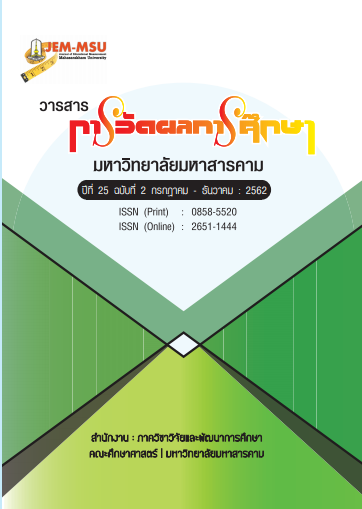Factors Influencing the Competencies of the Undergraduate Students in the Business Administration Program in the State Universities in the Eastern Economic Corridor
Main Article Content
Abstract
The purpose of this research was to find the factors that influence the competencies of undergraduate students in the business administration curriculum of the state universities in the Eastern Economic Corridor or the EEC. The researcher used the quantitative research technique by creating a questionnaire for analysis of organizational structure factors, technological factors, and behavioral factors that influence the competencies of undergraduate students in the business administration curriculum of the state universities in the Eastern Economic Corridor. The questionnaires were returned from 865 undergraduate students of the 3 main state universities in the EEC area, namely Burapha University in Chonburi, Rajamangala University of Technology Tawan-ok, Bang Phra, Chonburi Province, and Rajabhat Rajanagarindra University, Chachoengsao.
The results of the research revealed that: Aspect 1): regarding the organizational structure factors that influenced the students’ competencies, the aspect of communication in the organization had the highest influence on the student's competencies, with B = 179, followed by the aspect of downsizing of the organization, with B = 157. The aspect of construction of rules or working condition came third, with B = 155. The aspect of creation of work came fourth, with B = 137 and the aspect of organizational restructuring had the fifth highest influence on the students’ competencies, with B = 131. Aspect 2): regarding technological factors influencing the students’ competencies, it was found that using technology in work had the highest influence on the competencies of the students, with the value of B = 226, and making innovation came second with the value of B = 108; and Aspect 3): regarding behavioral factors that influenced the students’competencies, it was found that establishing organizational culture had the highest influence on the students’ competencies, with the value of B = 246, improving the behavior of the people in the organization (behavioral dissolution) came the second, with the value of B = 146; the immediate problem solving came third, with the value of B = 141; the organizing of activities came fourth, with the value of B = 127; and the mentoring came fifth, with the value of B = 93.
Article Details
The content and information contained in the published article in the Journal of Educational Measurement Mahasarakham University represent the opinions and responsibilities of the authors directly. The editorial board of the journal is not necessarily in agreement with or responsible for any of the content.
The articles, data, content, images, etc. that have been published in the Journal of Educational Measurement Mahasarakham University are copyrighted by the journal. If any individual or organization wishes to reproduce or perform any actions involving the entirety or any part of the content, they must obtain written permission from the Journal of Educational Measurement Mahasarakham University.
References
ธารินี แขวงเมือง. (2555). ระบบสารสนเทศในองค์กร ESS,TPS,MRS,DSS,KWS,OAS. (ออนไลน์).
สืบค้นจาก : https://tharinee55.blogspot.com/2012/11/esstpsmrsdsskwsoas.html.
เนตร์พัณณา ยาวิราช. (2558). การพัฒนาองค์การและการเปลี่ยนแปลง (Organization Development and Change). พิมพ์ครั้งที่ 1. กรุงเทพฯ : โรงพิมพ์ บริษัท ทริปเพิ้ล กรุ๊ป.
ระพินทร์ โพธิ์ศรี. (2551). สถิติเพื่อการวิจัย (Statistics for Research). พิมพ์ครั้งที่ 2. กรุงเทพฯ : สำนักพิมพ์ แห่งจุฬาลงกรณ์มหาวิทยาลัย.
สุดารัตน์ ไชยประสิทธิ์. (2559). กลยุทธ์การบริหารเพื่อเสริมสร้างการเป็นองค์กรสมรรถนะสูงของวิทยาลัย พยาบาลสังกัดกระทรวงสาธารณสุข. วารสารวิทยาลัยพยาบาลบรมราชนนี อุตรดิตถ์, 8(2), 112-130.
อภิชัย ธิณทัพ. (2556). การแทรกแซงเพื่อการพัฒนาองค์กร. (ออนไลน์). สืบค้นจาก : https://www.gotoknow. org/posts/208241. 27 พฤษภาคม 2559.
อาภรณ์ ภู่วิทยพันธุ์. (2553). การจัดทำเส้นทางการฝึกอบรมระยะยาวบนพื้นฐานของขีดความสามารถ (พิมพ์
ครั้งที่ 1). กรุงเทพฯ: พิมพ์ดีการพิมพ์.
Argyris, C. (1970). Intervention theory and method. Reading, MA : Addison – Wesley.
Boyatzis, R. E. (1982). The Competent manager: a model for effective performance. New York: Wiley.
Byham, W. C., & Moyer, R. P. (1970). Using competencies to build a successful organization. Retrieved from https://onpointcoaching.typepad.com/files/using_competancies_to_
build_org.pdf.
Cochran, W.G. (1953). Sampling Techiques. New York : John Wiley & Sons. Inc. Donald R. Brown. (2011). An Experiential Approach to Organization Development (Eighth Edition). (P.195-205). United States of America : Pearson Education, Inc., publishing as Prentice Hall, One Lake Street, Upper Saddle River, New Jersey.
Kurt Lewin. (1951). Field Theory in Social Science. New York : Harper & Rawl Lamarsh , J.
Ledford, G. E. Jr. (1995). Paying for skills, knowledge and competencies and knowledge workers. Compensation and Benefits Review, 56-62.
Leemann, J. E. (2005). Delivering business value by linking behavioral EHS competencies to corporate core competencies. International Journal for Sustainable Business. 12(1), 3-16.
Mark Connelly. (2016). The Kurt Lewin Change Management Model. (ออนไลน์). แหล่งที่มา : https://www.change-management-coach.com/kurt_lewin.html.
McClelland, D. C. (1973). Testing for competence rather than for intelligence. American Psychologist, 28, 1-14.
Mind Tools. (2017). Lewin's Change Management Model. (ออนไลน์). แหล่งที่มา: https://www.
mindtools.com/pages/article/newPPM_94.htm.
Michael E. McGill. (1977). Organization Development For Operating Managers (New York: A Divisions of American Management Association), p. 3.
Spencer, L. M. Jr., & Spencer, S. M. (1993). Competence at work: models for superior performance. New York: John Wiley & Sons.
Thomas G. Cummings and Christopher G. Worley. (2015). Organization Development & Change (10th ed.). USA : Cengage Learning.
Wendell L.French and Cecil H.Bell. (1973). Organization Development: Behavioral Science Interventions for Organization Improvement. Englewood Cliffs: Prentice-Hall.
Zingheim, P. K., Ledford, G. L. Jr., & Schuster, J. R. (1996). Competencies and competency models: does one size fit all?. ACA Journal, 5(1), 56-65.


